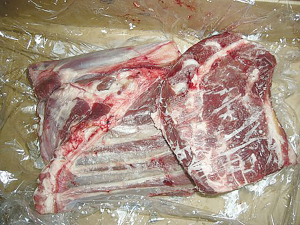New export records for Aussie goatmeat
The Australian goatmeat industry set a new record for production and exports last year.
 Goat meat: There are specific markets for different sized goats with traditional ethnic preferences, especially festival, needs for small goats.
Goat meat: There are specific markets for different sized goats with traditional ethnic preferences, especially festival, needs for small goats.
Why have processor/exporters not encouraged more goat meat when it sells at comparable retail prices to lamb in USA?
This was me first question in my last article. Read 'What about the potential of goat meat exports?' here.
Goats have negatives for the processors. They are not easily handled in the yards to separate lines. Plant operations are affected by different sized animals in a line that slows chain speed and supplied numbers may not match bookings.
With a total NZ goat kill about 120 000 head, spread over several plants, the relatively small numbers do not produce enough by-products to market at profitable prices. So, these end up as pet food, even while there is a premium – such as $US6 per lb for kidney and liver. Goat skins have the same problem – with low interest from buyers in relatively small numbers of variable sizes and qualities.
There are specific markets for different sized goats with traditional ethnic preferences, and especially festival, needs for often small goats. Yet a specific processing issue is small kids are expensive to slaughter with no sale products other than meat.
However, in the US live auction market of 21- 25- 28 kg LW kids there was a 2.5-5% value discount at each step as weight increased. While at 38kg LW or 17 kg CW, kids were discounted by over 15% indicating that market premium for light animals could help to counter higher processing costs.
Traditionally, some processors have successfully used goat slaughter as a plant management strategy to occupy staff and spread overheads during down times with other stock. Fabrication is simple and cheap; with either whole carcases or six-way cuts – no costs for added value, frozen storage and no trade restrictions.
Outside of supplies to a couple of traditional markets, meat is often spot traded – influenced by storage space priority, product competition, supplies, exchange rates and other marketing dynamics. Delivery can be simple by including goat with other frozen meat products.
However, such a processing regime prioritises other stock; so limited goat slaughter times can disadvantage goat farmers. Changing any of this – to access and develop one of more market segments for higher prices – needs farmers to commit to and address processing problems and supply specified numbers of standardised sized stock in identified lines.
These issues can be solved with better co-ordination and cooperation. Higher market returns would encourage more slaughter numbers to slowly overcome by-product and skin limitations and enhance returns.
About the author
Garrick Batten has a long professional and practical career in the goat sector. He has farmed goats for 30 years and written several goat books. His latest book is: ‘Big Buck$ for Pastoral Farmers’. It is especially for livestock farmers new to commercial goat farming. It is available from: https://www.copypress.co.nz/real-nz-books
A New Zealand dairy industry leader believes the free trade deal announced with India delivers wins for the sector.
The Coalition Government will need the support of at least one opposition party to ratify the free trade deal with India.
Primary sector leaders have welcomed the announcement of a Free Trade Agreement between India and New Zealand.
At Pāmu’s Kepler Farm in Manapouri, mating has wrapped up at the across-breed Beef Progeny Test.
More than 150 people turned up at Parliament recently to celebrate the 20th anniversary of Horticulture New Zealand (HortNZ).
Biosecurity New Zealand says Kiwis should continue to keep an eye out for yellow-legged hornets (Vespa velutina) over the holiday season.

OPINION: The release of the Natural Environment Bill and Planning Bill to replace the Resource Management Act is a red-letter day…
OPINION: Federated Farmers has launched a new campaign, swapping ‘The Twelve Days of Christmas’ for ‘The Twelve Pests of Christmas’ to…